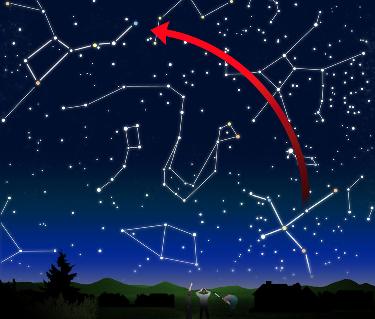What would give a neutron star the kind of push that would send it out of the galaxy at over 1000 kilometers per second? Nobody knows, but data from the Very Long Baseline Array, a system of radio telescopes spanning 5,000 miles with locations from Hawaii to the US Virgin Islands, have revealed just such an object, and have allowed astronomers to measure its motion with unprecendented accuracy.
“This is the first direct measurement of a neutron star’s speed that exceeds 1,000 kilometers per second,” said Walter Brisken, a National Radio Astronomy Observatory astronomer. “Most earlier estimates of neutron-star speeds depended on educated guesses about their distances. With this one, we have a precise, direct measurement of the distance, so we can measure the speed directly,” Brisken said.
The star’s speed translates to 670 miles per second, numbingly fast, but even at these speeds, an object like this would still take 1200 years to cross the 4.3 light years that separates us from the nearest stars. By comparison, the fastest manmade object, Voyager 1, is now moving at some 17.3 miles per second. As always, interstellar distances first elevate and then challenge our perspectives.

Image: Over about 2.5 million years, Pulsar B1508+55 has moved across about a third of the night sky as seen from Earth. Credit: Bill Saxton, NRAO/AUI/NSF.
The spinning neutron star, or pulsar, is labelled B1508+55 and is currently some 7700 light years from Earth. There seems little doubt it originated in the constellation Cygnus, doubtless the result of a supernova explosion of a massive star some two and a half million years ago. And it is headed away from the plane of the Milky Way on a trajectory that will take it completely out of the galaxy.
Centauri Dreams‘ take: No doubt supernova explosions can leave their neutron star remnants moving at high speeds, but the scientists involved with this study — and it’s part of a larger VLBA attempt to measure the motion of other pulsars — have no computer models that produce speeds like that of B1508+55. Which means that the models are in need of work, and implies that the VLBA study will produce more than a few modifications to our understanding of pulsars and the explosions that produce them. For more, see this NRAO news release.


Astrophysics, abstract
astro-ph/0702735
From: Vasilii Gvaramadze [view email]
Date: Wed, 28 Feb 2007 10:33:42 GMT (59kb)
Hyperfast pulsars as the remnants of massive stars ejected from young star clusters
Authors: V.V.Gvaramadze, A.Gualandris, S.Portegies Zwart
Comments: 11 pages, 6 figures, 1 table
Recent proper motion and parallax measurements for the pulsar PSR B1508+55 gave the highest (transverse) velocity (~1100 km/s) ever measured for a neutron star (Chatterjee et al. 2005). The spin-down characteristics of PSR B1508+55 (typical of non-recycled pulsars) imply that the high velocity of this pulsar cannot be solely due to disruption of a tight massive binary system. A possible way to account for the high velocity of PSR B1508+55 is to assume that at least a part of this velocity is due to a natal kick or a post-natal acceleration (Chatterjee et al. 2005). We propose an alternative explanation for the origin of hyperfast pulsars based on the idea that they could be the remnants of a symmetric supernova explosion of a high-velocity massive star (or its helium core) which attained its peculiar velocity (similar to that of the pulsar) in the course of a strong three or four body dynamical encounter in the core of the parent young massive star cluster. Our proposal implies that the dense cores of young massive star clusters (located either in the Galactic disk or near the Galactic centre) could also produce the so-called hypervelocity stars (Brown et al. 2005) — the ordinary stars moving with a speed of ~1000 km/s.
http://arxiv.org/abs/astro-ph/0702735
I have proposed another possibility, planetary impacts after the star goes nova.
Bob Clark
RX J0822-4300 in Puppis A:
> Chandra Discovers Cosmic Cannonball
>One of the fastest moving stars ever seen has been discovered with NASA’s
>Chandra X-ray Observatory. This cosmic cannonball is challenging theories
>to explain its blistering speed. Astronomers used Chandra to observe a
>neutron star, known as RX J0822-4300, over a period of about five years.
>During that span, three Chandra observations clearly show the neutron star
>moving away from the center of the Puppis A supernova remnant.
>
>http://chandra.harvard.edu/photo/2007/puppis/
>